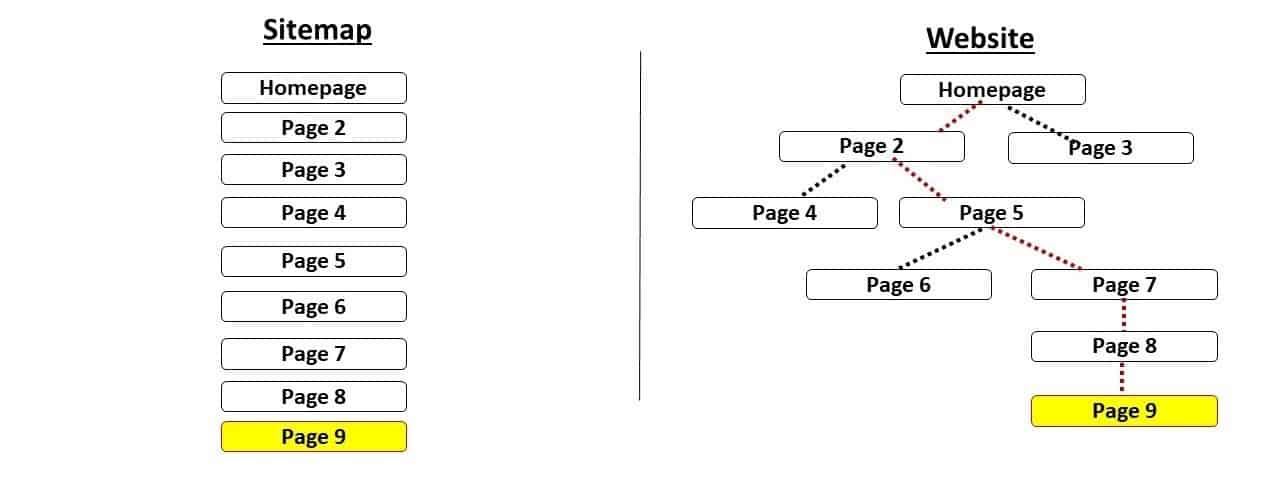nehagoyal022@gmail.com | Posted on | Education
What is SITEMAP in SEO?
| Posted on
A sitemap in SEO is a file that lists all the important pages on a website, along with their relationships to each other. Sitemaps help search engines like Google crawl and index websites more efficiently.
Sitemaps are typically created in XML format, and they can be submitted to Google Search Console so that Google can be aware of them.
Benefits of using a sitemap for SEO:
- Sitemaps can help search engines discover new and updated pages on a website more quickly.
- Sitemaps can help search engines understand the structure of a website and the relationships between its pages.
- Sitemaps can help search engines prioritize the crawling and indexing of important pages on a website.
- Sitemaps can help search engines identify and fix crawl errors.
How to create a sitemap:
There are a number of ways to create a sitemap, but the most common method is to use a sitemap generator plugin or tool. Once a sitemap has been created, it can be submitted to Google Search Console.

Also Read- What is technical SEO?
0
0 Comment
Student | Posted on
In the realm of SEO (Search Engine Optimization), a Sitemap is a structured list or map that provides information to search engines about the content and organization of a website. Essentially, it serves as a blueprint, aiding search engine crawlers in navigating and comprehending the structure of a site. This XML-based file includes URLs, metadata, and other relevant details about each page on the website.
A Sitemap offers several advantages for SEO. Firstly, it ensures that all the important pages of a website are indexed by search engines, enhancing the visibility of the site in search results. It's particularly beneficial for large websites or those with complex structures, where some pages might be challenging for search engines to discover through regular crawling.
Additionally, a Sitemap provides an opportunity to communicate the priority and frequency of updates for different pages, helping search engines prioritize their crawling efforts. This is crucial for dynamic websites with frequently changing content.

0
0 Comment
nehagoyal022@gmail.com | Posted on
A sitemap is a blueprint of your website that help crawler to crawl and index all of your website's content.There are two types of sitemaps:HTML and XML. HTML sitemaps guide visitors or users. While XML sitemaps guide search engine bots, to ensure they find a site's URLs to index.A good XML sitemap acts as a roadmap of your website that leads Google to all your important pages. XML sitemaps play a crucial role in SEO by enabling Google to swiftly locate and index your vital webpages
How to create Sitemap:
- Gather all of your site's URLs.
- Code the URLs.
- Use Sitemap generator tool to generate Sitemap.
- Access Google Search Console and select "Sitemaps" from the left sidebar.
- Insert the URL of your sitemap in the designated section labeled "Add a new sitemap" at the top of the page.
- Click submit and Google will crawl your newly created XML sitemap.

0
0 Comment
| Posted on
A sitemap is a pivotal part of site improvement (Web optimization) that assumes a huge part in further developing site perceivability and rankings on web search tool result pages (SERPs). In this article, we will investigate what a sitemap is, its significance in Web optimization, how to make one, and best practices for improving it.
In straightforward terms, a sitemap is a record that rundowns every one of the pages on a site, permitting web search tools to effectively creep and list them more. It gives web crawler bots a guide of your site's design and content pecking order. Ordinarily, sitemaps are written in XML design, albeit different arrangements, for example, HTML are likewise utilized.
The main role of a sitemap is to assist with looking through motors find and figure out the substance on your site. By giving an exhaustive rundown of URLs, it guarantees that web search tools can without much of a stretch access and record every one of the important pages. This is especially valuable for sites with complex designs, dynamic substance, or pages that are not all around connected inside.
Here are a few key justifications for why sitemaps are significant for Website optimization:
1. Further developed slithering and ordering: Web crawler bots use sitemaps to explore through sites, it are found and listed to guarantee that all pages. By presenting a sitemap to web search tools like Google, you can accelerate the creeping system and increment the possibilities of your pages being filed.
2. Improved perceivability: When web crawlers have a reasonable comprehension of your site's design and content, they can show more precise and important outcomes to clients. This can prompt better perceivability and higher rankings on SERPs.
3. Indexation of non-connected pages: A few pages on your site may not be quickly open through interior connections. These could incorporate pages with restricted or no outer connections, powerfully produced content, or new pages that haven't been found at this point. A sitemap guarantees that such pages are as yet crept and filed via web indexes.
4. Need and newness pointers: Sitemaps permit website admins to give extra data about their pages, for example, need and last alteration date. This assists web search tools with figuring out the significance and recency of each page, affecting their creeping and ordering choices.
Now that we comprehend the significance of sitemaps, how about we investigate how to make one:
1. Begin with a sitemap generator: There are different instruments accessible that can naturally create sitemaps for your site. These devices slither your site, recognize every one of the pages, and make a sitemap record in the ideal configuration (e.g., XML). Some famous sitemap generators incorporate Shouting Frog, Yoast Web optimization module for WordPress.
2. Structure your sitemap: A very much organized sitemap is fundamental for both web crawlers and clients. It ought to mirror your site's order and obviously characterize the connections between various pages. Coordinate your URLs into intelligent classifications and subcategories, making it simpler for web crawlers to grasp the substance stream.
3. Incorporate every single pertinent page: Guarantee that your sitemap remembers every one of the significant pages for your site. This incorporates static pages as well as blog entries, item pages, class pages, and some other substance you maintain that web search tools should record.
4. Improve for crawlability: To boost the adequacy of your sitemap, think about the accompanying prescribed procedures:
- Keep the sitemap record size under 50MB and 50,000 URLs. In the event that your site surpasses these cutoff points, make various sitemap documents or utilize a sitemap list record.
- Utilize appropriate URL designs (e.g., authoritative URLs) to stay away from copy content issues.
- Remember just sanctioned URLs for your sitemap to forestall ordering of copy or inferior quality pages.
- Consistently update your sitemap to ponder changes your site. This should be possible physically or by utilizing mechanized devices that update the sitemap at whatever point new satisfied is added.

0
0 Comment
In the realm of digital marketing, an indispensable tool is the "sitemap." This invaluable file plays a pivotal role in enhancing a website's visibility and comprehension by search engines, notably the almighty Google.
Sitemaps come in two flavors:
1. XML Sitemap: Crafted with meticulous care for the discerning eyes of search engines, the XML sitemap is a structured directory of a website's URLs. What sets it apart is its ability to furnish additional data about each URL, including its last update. This feature empowers search engines to traverse and index a website with unparalleled efficiency.
2. HTML Sitemap: Tailored to cater to the human audience, the HTML sitemap takes the form of a webpage on the site. This user-friendly page offers a neatly organized roster of links to various web pages, simplifying navigation for visitors.
In the digital marketing playbook, possessing an XML sitemap is akin to an SEO home run. It guarantees that search engines can uncover and index all the vital pages on your website, ultimately boosting your site's prominence in search results. It's a winning strategy to improve your online visibility and overall SEO performance.

0
0 Comment
| Posted on
In SEO, a sitemap is a file or page that provides a structured and organized list of all the web pages and content on a website. It serves as a roadmap for search engine crawlers to navigate and index the site more efficiently. Sitemaps can be in XML or HTML format, and they help search engines understand the website's structure and hierarchy, ensuring that all pages are crawled and indexed. This improves a site's visibility in search engine results and enhances SEO by making it easier for search engines to discover and rank your content.
0
0 Comment
